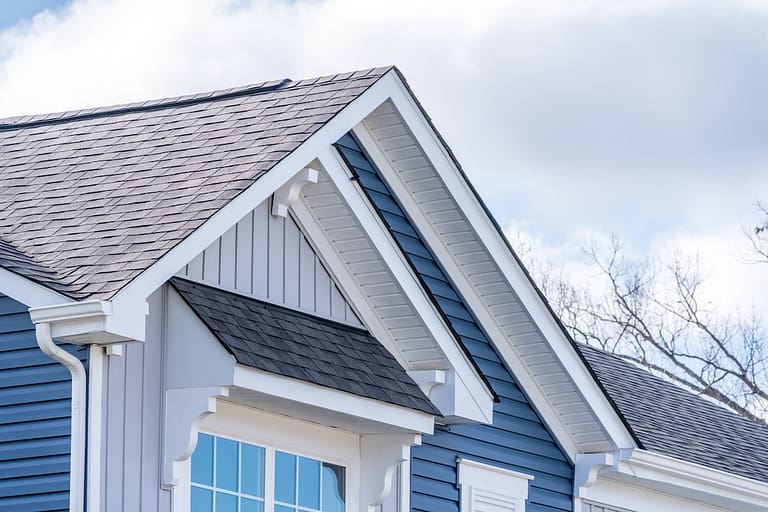Your roof: you see it everyday, and know how important it is. Yet, it’s easy to overlook its maintenance until a problem arises. When that happens, swift action is crucial to prevent further damage and costly repairs. But do you really need to call a professional?
In this guide from your local pro roofers, we’ll delve into:
- The world of DIY roof repair
- Identifying signs of damage
- The pros and cons of tackling the repairs yourself
Signs That You Need to Repair Your Roof

Before you grab your toolkit, it’s essential to recognize the signs that your roof may be in need of repair:
- Leaks: Water stains on your ceiling or walls, or water dripping into your home during rainstorms, indicate potential roof leaks.
- Missing or Damaged Shingles: Inspect your roof for missing, cracked, or curled shingles, as these can leave your roof vulnerable to water infiltration.
- Sagging: A sagging roofline suggests structural issues that require immediate attention.
- Granule Loss: Check your gutters for granules, as excessive granule loss from shingles can signify aging or damaged roofing materials.
- Mold or Mildew Growth: Moisture trapped in your attic or ceiling can lead to the growth of mold or mildew, indicating a potential roofing problem.
Differences Between Repairs and Replacements
Understanding the disparity between repairs and replacements is crucial in determining the best course of action for your roof:
Repairs:
Roof repairs address specific issues such as leaks, damaged shingles, or flashing problems without replacing the entire roof.
Replacements:
Roof replacements involve installing an entirely new roof due to extensive damage, age, or the desire for an upgrade. This is a more complex and costly endeavor compared to repairs.
Pros and Cons of DIY Roof Repair
Embarking on a DIY roof repair project offers both advantages and drawbacks:
👍 Pros:
- Cost Savings: DIY repairs can save you significant money on labor costs.
- Control Over Quality: You have complete control over the materials and techniques used, ensuring high-quality repairs.
- Learning Experience: DIY projects provide valuable learning opportunities and a sense of accomplishment.
👎 Cons:
- Safety Risks: Working at heights poses inherent safety risks, increasing the likelihood of accidents or injuries.
- Limited Expertise: Lack of experience and specialized knowledge may result in improper repairs, leading to further damage.
- Time and Effort: Roof repairs require time, effort, and attention to detail, which may be challenging for those with busy schedules.
When You Should Call Professional Roofers: 3 Signs
While DIY repairs can be rewarding, certain situations warrant the expertise of a professional roofer:
1) Complex Issues:
Structural damage, extensive leaks, or intricate repairs are best handled by experienced professionals.
2) Safety Concerns:
If you’re uncomfortable working at heights or lack the necessary safety equipment, it’s safer to leave the repairs to professionals.
3) Warranty Considerations:
Hiring a professional ensures that repairs adhere to manufacturer specifications, preserving any existing warranties on your roofing materials.
The Cost to Repair Your Roof
The cost of repairing your roof varies depending on several factors:
- Extent of Damage: The severity and extent of damage directly impact repair costs.
- Materials: The type and quality of materials used for repairs influence overall expenses.
- Labor: Labor costs for DIY repairs are primarily your time and effort, whereas hiring professionals entails labor fees.
- Additional Factors: Factors such as roof accessibility, location, and local labor rates also contribute to overall repair costs.
For minor repairs like patching small leaks or replacing a few damaged shingles, DIY costs typically range from $100 to $500, whereas hiring a professional may cost between $300 to $1,500 or more, depending on the complexity of the job.
Will Insurance Cover the Costs?
Whether insurance covers the cost of roof repairs depends on the cause of the damage and your insurance policy:
- Covered Perils: Most homeowner’s insurance policies cover roof damage caused by covered perils such as fire, windstorms, or falling objects.
- Exclusions: Damage resulting from neglect, wear and tear, or lack of maintenance may not be covered by insurance.
- Deductibles: You’re responsible for paying the deductible outlined in your policy before insurance covers the remaining repair costs.
- Policy Limits: Insurance policies often have coverage limits, so it’s essential to review your policy to understand the extent of coverage for roof repairs.
To maximize insurance coverage, document the damage with photographs, obtain repair estimates from reputable contractors, and promptly file a claim with your insurance provider.

No Need for DIY Roof Repairs! Contact Your Local Roofing Contractor At Johnson Restoration
DIY roof repair can be a cost-effective solution for minor issues, but it’s essential to recognize when professional intervention is necessary. By understanding the signs of roof damage, weighing the pros and cons of DIY repairs, and considering factors such as cost and insurance coverage, you can make informed decisions to safeguard your roof and your home. Remember, a well-maintained roof is not only a wise investment but also provides peace of mind knowing your home is protected from the elements.
If you’re dealing with a leaky roof, missing shingles, or other forms of roof damage, then you need Johnson Restoration! Contact us today to learn more about our services!






